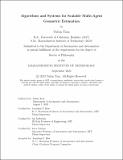| dc.description.abstract | Collaborative geometric estimation, which enables multiple agents to construct globally consistent geometric models of the environment (e.g., maps and robot poses) from noisy local measurements, is a crucial capability for multi-agent systems. However, achieving scalable collaborative estimation in the real world is challenging. On one hand, solving the underlying geometric optimization problems is hard due to the coupling among agents and poor numerical conditioning. On the other hand, realworld communication networks impose operational constraints (e.g., in the form of available bandwidth) that need to be accounted for during deployment.
This thesis develops algorithms and systems toward enabling scalable collaborative geometric estimation, with a focus on tackling the aforementioned technical challenges. The first part of this thesis considers geometric estimation under a fully distributed communication architecture, in which agents directly communicate with each other without relying on a central server. To this end, this thesis presents distributed pose graph optimization algorithms with the goals of achieving certifiable global optimality and convergence under asynchronous communication. Leveraging the developed algorithms, this thesis then develops a complete system for distributed simultaneous localization and mapping (SLAM), and demonstrates the proposed system in large-scale urban environments where up to 8 ground robots traverse a total distance close to 8 km. The second part of this thesis tackles geometric estimation under a server-client architecture, where a server coordinates communication during collaborative optimization. To this end, this thesis presents a communication-efficient solver that enables large-scale collaborative mapping with significantly reduced communication. Furthermore, specialized solvers for collaborative rotation averaging and translation estimation are developed, which exploit spectral graph theoretic methods to achieve fast convergence. These algorithmic contributions, together with opensource code and datasets, facilitate the development of scalable multi-agent perception systems in complex environments. | |
